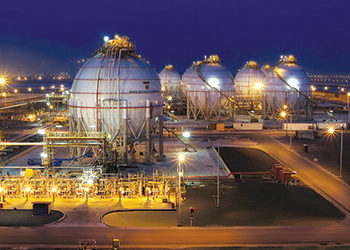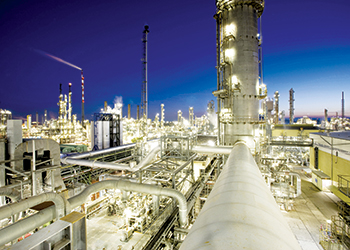
 Khanlari ... digitalisation is key to minimising carbon footprint
Khanlari ... digitalisation is key to minimising carbon footprint
A comprehensive vision across the production value chain is needed for overall operational efficiency, profitability, and sustainability, Anahita Khanlari of Aspen Technology, tells OGN
For the next few decades, chemicals demand will increase worldwide, putting pressure on chemical producers to increase production. Yet in view of the climate and environmental crises, the industry is facing a dual challenge.
There is a need for companies to adopt creative solutions and reuse or recycle materials to create a circular economy instead of a linear one, Anahita Khanlari, Industry Marketing Director, Chemicals, Aspen Technology, says.
The UN Sustainable Development Goal (SDG) number 12 highlights the idea of "responsible consumption and production", which many chemical companies have adopted and internalised as a guideline.
There have been various approaches to increase resource efficiency in the chemical industry. The pursuit of energy efficiency is a low hanging fruit which might not need significant capital investments.
In the face of geopolitical conflicts, energy security and improving energy efficiency has become the main concern for chemical executives.
Another approach to increase resource efficiency is reusing materials as feedstock similar to what is being done with advanced recycling of plastics.
 |
Figure 1 ... A circular value chain view for the chemical manufacturing industry |
It is critical to note that in the journey towards optimal resource efficiency, bulk chemical manufacturers might adopt a different set of strategies, compared to smaller specialty chemicals manufacturers. For example, reducing Scope 1 emissions is a very pressing topic for an ethylene producer.
At the same time, a specialty polymer manufacturer might focus on waste elimination and the circularity of their products.
Regardless of size, nature, and priorities of a chemical manufacturing facility, digital solutions are instrumental in their journey to maximise resource efficiency.
A comprehensive vision across the production value chain is needed for overall operational efficiency, profitability, and sustainability.
EFFECTIVE PLANNING & SCHEDULING
Due to unprecedented pressure exerted on global supply chains during the pandemic, subsequent disruptions cascaded throughout the energy and chemicals industry. While the demand for plastics in healthcare skyrocketed, demand for energy plummeted.
As the world transits back to pre-pandemic dynamics, the conflict in Europe added to market instability.
To mitigate rapidly shifting market conditions, integrating upstream and downstream models can help chemical companies stay profitable.
Production planning and scheduling can address product demands, while conserving resources (like feedstock) to maximise production margins.
For example, Sadara leveraged Aspen PIMS-AO to adjust cracker operation and to decide which aromatics to import, to choose feedstock, and to decide the best distribution of monomer products in an integrated and coordinated way.
IMPROVE ENERGY EFFICIENCY & LIMIT CARBON FOOTPRINT
While chemical producers experiment with new business models to take advantage of new feedstocks, new energy sources, and new products, many have pledged to reduce their carbon footprint and become carbon neutral by 2050.
Like the EU’s Emissions Trading System (ETS), other regions of the world are considering implementing carbon taxes in the form of trading markets.
Deviations from these targets would impose high operational costs and cut significantly through profit margins. Free allowances are expected to be reduced, which will in turn increase permit prices.
Energy efficiency of the main process becomes just as important as reducing fuel gas and steam demand on the utility side – as both measures are now business longevity mandates.
Considering market competitiveness, feedstock volatility and low margins for commodity chemical producers, slight improvements in operations to increase energy efficiency can significantly impact producers’ bottom line.
Creating a digital twin of the plant can help identify site-wide opportunities to improve energy efficiency without the need for capital investment.
For example, leveraging utilities digital twin, SABIC utility engineers were able to determine which boilers to use, select best source of steam with the highest energy savings, optimise steam supply, and determine the best drive in multi-drive equipment with electrical motors. Their effort led to 130 GJ/h energy savings at a single site.
It is also possible to optimise utilities, such as fuels, hydrogen and steam, to improve profitability and lower carbon footprint.
One way for large chemical manufacturers to improve energy efficiency is through active utilities management. Digital solutions like advanced process control (APC) and digital twins provide visibility and control over utilities operations, emission levels, and opportunities to minimise them.
APC has been used in process industries for decades to improve process efficiency. In addition to solving nonlinear problems, leveraging AI and machine learning (ML), new APC tools learn from historic performance of the plant and enable users to optimise for desired economic and operational variables in a fraction of the time.
Equally, digital twins are strong tools for tracking and managing emissions while providing insights to remove process bottlenecks.
Digital twins facilitate monitoring at the equipment level, locating emission sources, and helping to validate and reconcile site-wide data that can be used for reporting and decision-making purposes.
REDUCING WASTE GENERATION
Waste generation in the chemical industry accounts for a large portion of total waste produced globally. This waste can be in the form of liquid, solid or gaseous material.
Since the chemical industry consumes significant amounts of water to cool down processes or as part of the process, wastewater accounts for the largest stream of waste produced.
To minimise waste generation, the chemical industry has leveraged digital solutions in different ways. This works by balancing proactive strategies to prevent or minimise waste generation in the first place, followed by strategies to manage generated waste.
Both aspects of this circular approach benefits well from the implementation of digital solutions.
Flaring in manufacturing plants is an example of waste generation with environmental impacts on nearby communities.
Reducing the need for further product treatment or minimising catalyst decay are other examples of waste minimisation in the chemical industry.
CONCLUSION
To meet new technological and environmental challenges, the chemical industry is using digital technology more than any other time.
Digital solutions are essential to improve resource efficiency and minimise the carbon footprint of the industry’s operations.
Aspen Technology’s digital solutions has helped clients improved overall reliability, productivity, and efficiency of their plants without any new capex investments.
Considering companies' limited resources, along with increasing customer demands for responsible production, and the competitiveness of the chemicals market, chemical manufacturers are on fast track to revolutionise operations and take advantage of additional revenue opportunities.
The combination of global chemicals demand growth and sustainability pressures, together with the complexities of a volatile market require new levels of operational agility, flexibility and insights.
Chemical industry leaders are adopting digital solutions as an essential component of industry transformation to improve resource efficiency and minimise the carbon footprint of the operations.
Digital solutions provide operational insight and create value in every segment of the chemicals value chain from supply chain to design, production, and reliability and maintenance.











































































